If you were to hold a competition for the strangest-looking creature on earth, the armadillo would have a good chance of winning.
With its armored shell, long nose, and big ears, the armadillo is both comical and bizarre. They also have a habit of leaping into the air when startled, which makes them even more fun to watch.
Armadillos are the only armored mammals in the world, and their unique appearance has baffled scientists for years. Are the benefits of wearing a permanent suit of armor sufficient to offset the negatives?
We’re going to explore that topic in more detail while uncovering some other cool facts about armadillos, where they live, and how they survive.
What’s It Like To Be an Armadillo?
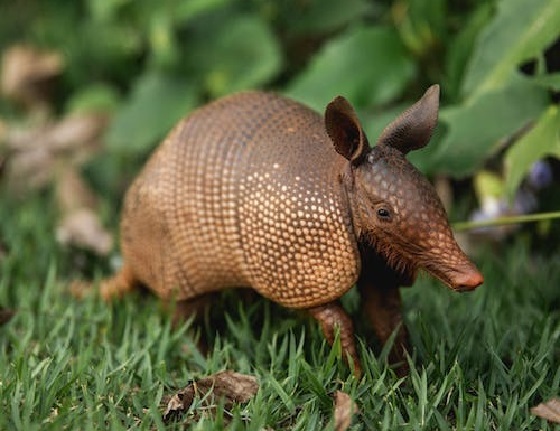
Being an armadillo means taking life slowly. Armadillos are related to sloths, and like their cousins, spend large portions of every 24-hour period fast asleep. While sloths use their sharp claws for climbing, armadillos use theirs to dig burrows and forage for food.
None of the existing armadillo species are what you’d call sociable, and while the females raise their young for the first 12 months of their lives, once they’re weaned, the mothers happily return to a solitary existence.
If you’re a three-banded armadillo, you’ll spend some parts of the day and night curled into a ball, but if you belong to one of the other 20 species of armadillo, you’ll simply lug your armor around with you until you’re so exhausted that you fall into a deep sleep, lasting up to 16 hours of the day!
That’s right! Only the nine-banded armadillo curls itself into a ball, even though this is the behavior that springs to mind whenever we think of armadillos. So what do the rest of the armadillo species do with their shells?
The Structure and Purpose of the Armadillo’s Shell
Like a tortoise’s shell, the armadillo’s shell is made up of two distinct layers. The top or outer layer consists of keratin, which is the substance found in our fingernails. Beneath this is a shell-like skin known as an osteoderm, which is made up of bone-like tiles that can be either triangular or hexagonal.
Collagen fibers known as Sharpey’s fibers connect these tiles, creating a shell that combines the properties of both hard and soft tissues.
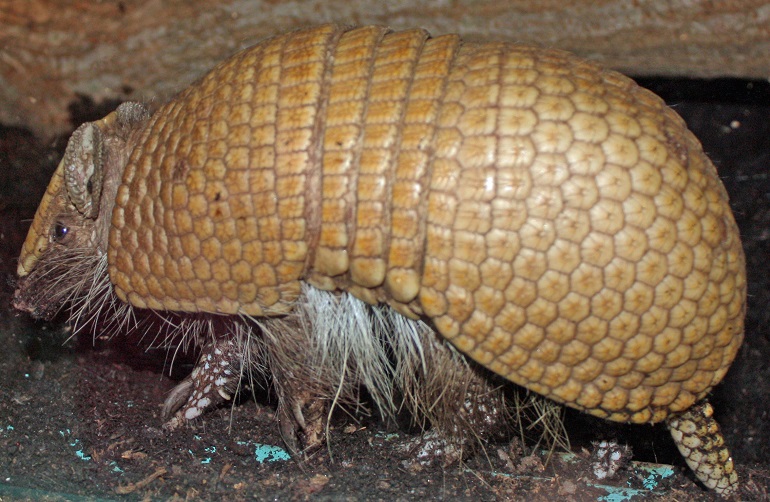
The bands on the back of the armadillo’s shell are hard like your fingernails, but the sections in between are flexible, allowing the shell to expand and contract as the animal moves.
The armadillo’s shell covers its back, neck, and tail, presumably offering protection against potential predators. It also stops the armadillo from sustaining injuries as it scurries through the undergrowth.
The armadillo’s shell isn’t only there for protection against predation – it also safeguards the animal against extreme weather conditions, maximizing heat loss so the armadillo can survive the hot temperatures of its chosen habitat.
Nevertheless, wearing armor 24 hours a day isn’t all it’s cracked up to be. While other mammals can take deeper breaths to compensate for low-oxygen conditions, the armadillo can’t.
Its shell fits so snugly that it makes its thorax rigid. This restricts airflow and means the armadillo must compensate by breathing more quickly.
What Do Armadillos Look Like?
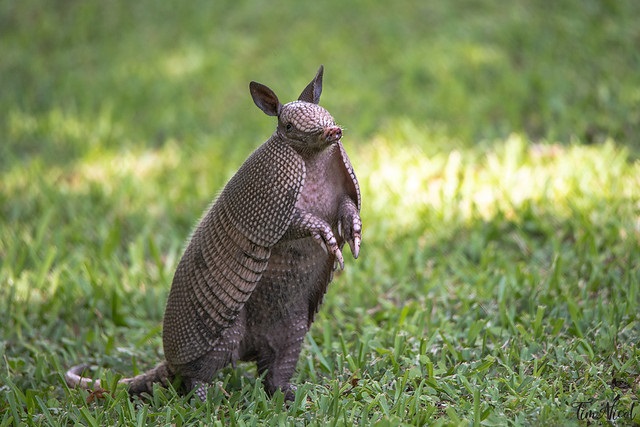
It’s only recently that I discovered how many species of armadillos there are in the world and that you can tell the difference by counting the number of bands on their shells.
All armadillos have similar features, including long noses, oversized ears, and thick, strong claws, but that’s where the similarities end. The most familiar species is the nine-banded armadillo which, as its name suggests, has nine distinct bands on its back.
The three-banded armadillo looks similar, but guess what? It only has three bands instead of nine! It’s also the only species of armadillo that can curl itself into a ball.
Some armadillos are fairly conservative about their appearances, with the nine-banded armadillo sticking to a uniform of brown or gray. Others are more eccentric, with the pink fairy armadillo sporting a carapace the color of strawberry milkshakes.
What Size Is the Average Armadillo?
Armadillos also vary in size, with the pink fairy armadillo being so small, you could easily lose it under a dollar bill. In contrast, a giant armadillo’s body measures around 30–39 in, which is the equivalent of a golf club or guitar. The tail makes the giant armadillo even longer, extending it by an additional 20 inches.
What’s So Special About Nine-Banded Armadillos?
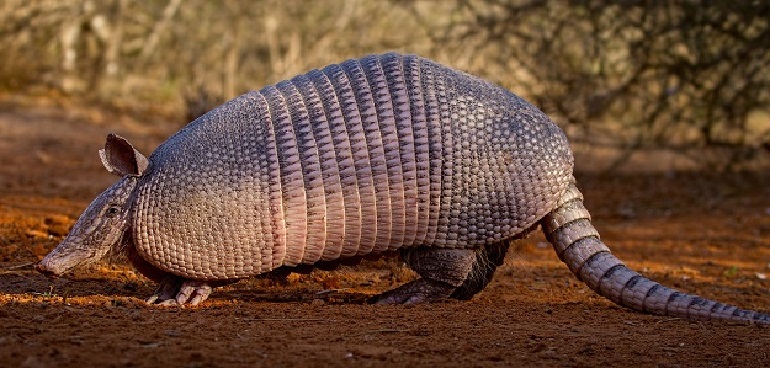
The nine-banded armadillo (Dasypus novemcinctus) is the only species of armored mammal found in the US, with the others occurring in Central and South America.
Nine-banded armadillos like warm, damp climates, and often frequent grasslands and forest habitats.
In addition to carrying a shield with them wherever they go, nine-banded armadillos have a few other curious adaptations. I bet you didn’t know that a nine-banded armadillo can hold its breath for up to six minutes and can walk along the bottom of a river much like a hippo.
They are nocturnal creatures and prolific diggers that can become a nuisance if they decide to forage or burrow in gardens, lawns, and golf courses.
Like all armadillos, the nine-banded has very poor eyesight, which often leads to it wandering out into the road, oblivious of the oncoming traffic.
At roughly the size of a domestic cat, the nine-banded armadillo is small enough that most vehicles could pass right over the top without causing any damage.
Why the Armadillo’s Defense Mechanism Is Killing It
Unfortunately, one of the armadillo’s defense mechanisms is to leap vertically into the air, which causes them to collide with the undercarriage of vehicles – an experience few survive.
The Classification and Paleontology of the Armadillo
When Darwin arrived in South America, he uncovered the fossilized remains of huge, extinct, armored mammals that became known as glyptodonts.
These enormous ancestors of modern-day armadillos were so heavily armored, they could weigh up to 2,000 kgs, which could explain why the more modern armadillos were called “little armored ones.”
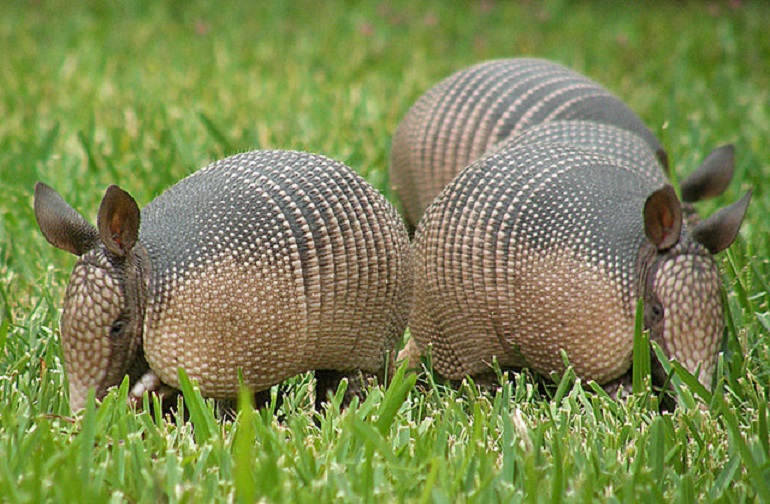
The Etymology of the Name Armadillo
While the common name for the armadillo comes from a Spanish word meaning “little armored one,” but its scientific name has Greek roots.
Dasypodidae is the term used to describe the taxonomic family armadillos belong to, and it is a combination of two words.
The first means either hairy or shaggy, while the second means foot. Therefore, to the Greeks, armadillos were hairy feet!
The Evolutionary Status of the Modern-Day Armadillo
Glyptodonts disappeared around 10, 000 years ago, leaving modern-day armadillos to flourish.
It was only when North and South America joined that the armadillo faced potential danger. Until that point, it was relatively isolated, living in remote regions free of predators.
The newly formed land bridge brought numerous carnivores into the area, forcing the armadillo to stage a counter-attack by heading north.
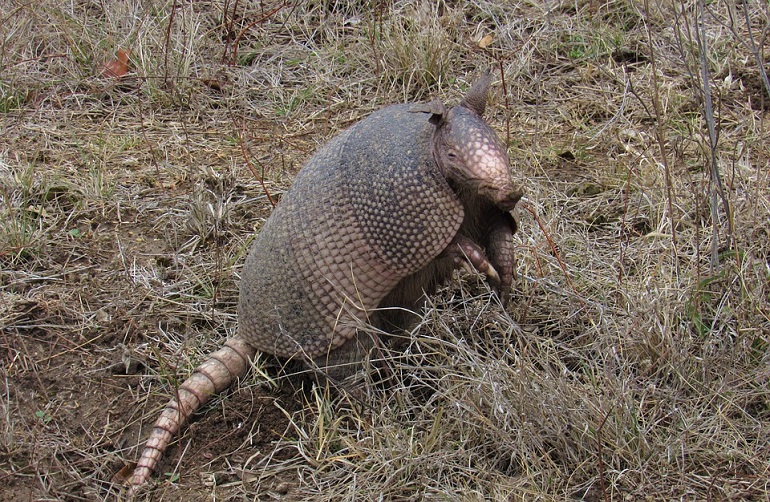
Where Do Armadillos Live?
In the US, armadillos are most commonly seen in Texas, where the soil is soft enough for the nine-banded armadillo to forage for grubs and insects. This species of armadillo has expanded its territory in recent years, moving into the southern and midwestern United States.
Armadillos can also be found further south and are relatively common throughout Mexico.
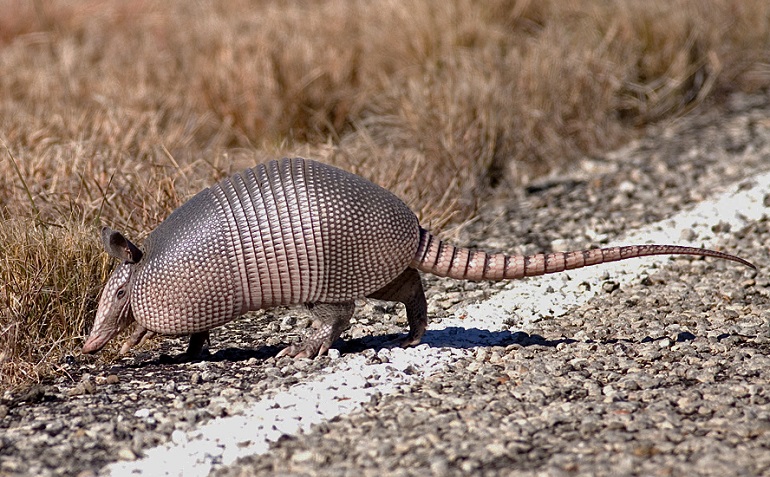
If we head even further south to Colombia and Venezuela, we enter the home range of the Llanos long-nosed armadillos. Keep going, and you’ll come across the Andean hairy armadillo making its home in Bolivia and parts of Peru.
The pink fairy armadillo calls the sandy plains and scrubby grasslands of central Argentina home, while giant armadillos prefer creeks and the undisturbed forests in the north of the country.
Once you reach Uruguay, you’ll find the greatest diversity of armadillos anywhere in the world. Here, six-banded armadillos occupy rainforests and open grasslands alongside the southern long-nosed armadillo and the nine-banded.
The giant armadillo is more selective, seeking out habitats where large populations of termites provide enough food to satisfy their considerable appetites.
The Armadillo’s Strange Characteristics and Adaptations
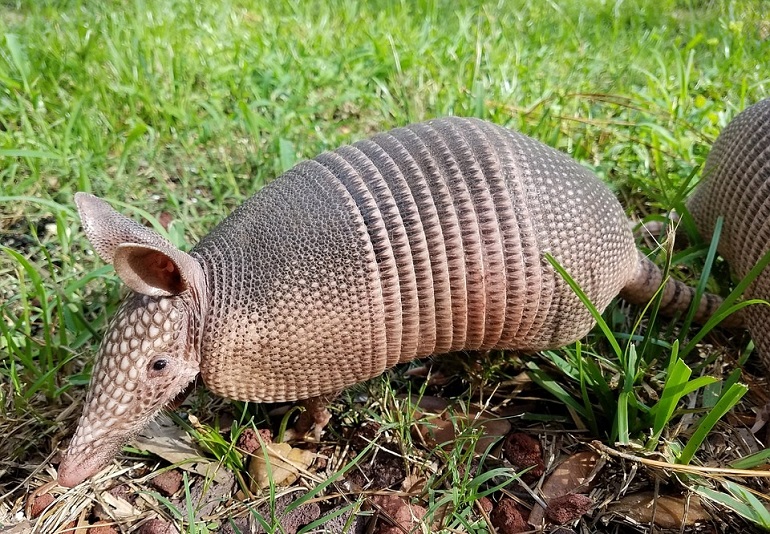
Many armadillos are active at night, using the cover of darkness to protect them against predators. But there’s always an exception to every rule, and in this case, that’s the six-banded armadillo.
This is the only species that is most active during the daytime and, as it can’t roll itself into a ball like the three-banded armadillo, relies on diving into nearby burrows at the first sign of danger.
The Armadillo’s Ambling Movement Disguises Its Speed
Armadillos are generally thought of as slow, lumbering animals, but that couldn’t be further from the truth. If they need to, armadillos can reach a top speed of 30 mph, which means they can be safely inside a burrow in a matter of seconds.
How Do Armadillos Regulate Their Body Temperature?
Armadillos also use their burrows to regulate their body temperature. While their carapaces maximize heat loss, keeping them cool in hot weather, when the temperature drops, it offers little in the way of insulation.
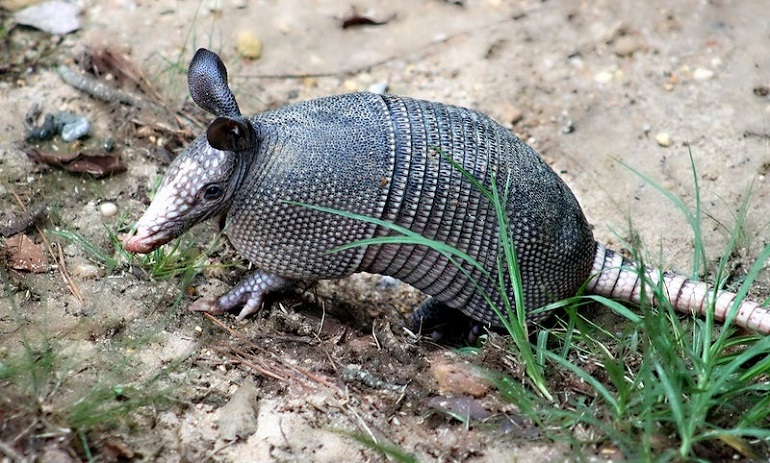
Instead, many armadillos, including the yellow or six-banded armadillo, snuggle in their burrows until they warm up. In extreme cases, the usually solitary armadillo may open its burrow up to others so they can share each other’s body heat.
Diet and Predation in the Life of an Armadillo
Armadillos are related to anteaters and enjoy a similar diet. Both species use their sharp claws and long noses for foraging and digging up termites and ants.
While the anteater eats almost nothing else, armadillos are less picky and will happily consume small invertebrates like beetles and other bugs.
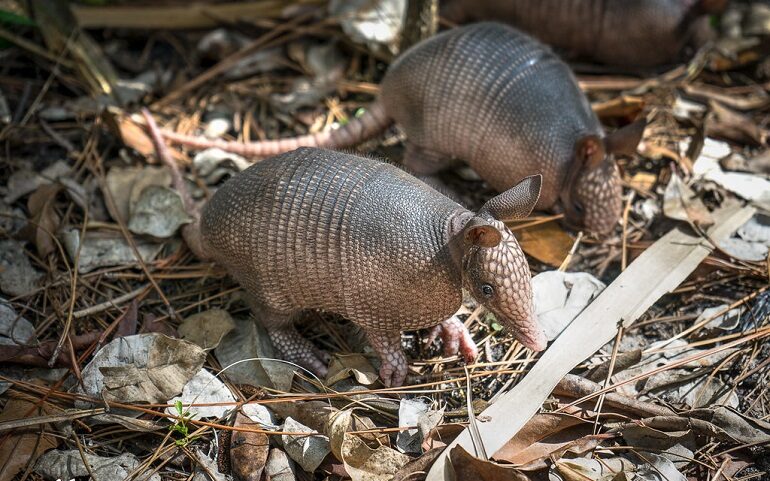
They’re highly adept at digging for prey but equally confident foraging for fruit and even the eggs of birds and reptiles.
Armadillos use their keen sense of smell to track down the juiciest bugs and sometimes keep their snouts in the ground so long that it makes it difficult for them to breathe!
What Kind of Animals Prey on Armadillos?
Armadillos are at their most vulnerable when their noses are buried in the ground as they rely on the sense of smell to alert them to potential predators. Coyotes are the most effective at taking advantage of this, but even they find the armadillo’s shell a bit of a mouthful!
Other animals that prey on armadillos include bears, bobcats, cougars, and wolves. Large birds of prey will also consider taking on an armadillo but are more likely to target the younger armadillos, or pups, whose carapaces are softer and easier to penetrate.
How Polyembryony Works for the Armadillo
Nine-banded armadillos have another curious adaptation known as polyembryony. Through this process, a single fertilized egg splits into several different embryos. The nine-banded armadillo nearly always gives birth to identical quadruplets that are carbon copies of one another.
Other species of armadillos give birth to anywhere between one and 12 pups, each of which is covered in a leathery skin that later develops into a hard carapace.
The Reproduction and Life Expectancy of the Armadillo
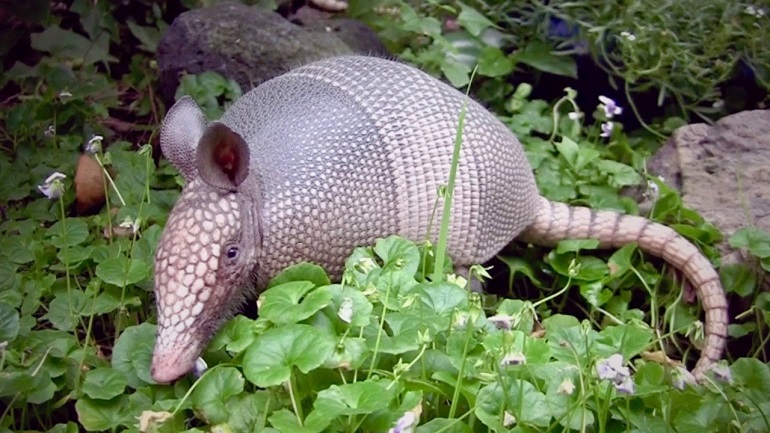
It’s not easy making love when you’re wearing full-body armor, so the armadillos had to develop some very specific traits and tricks to master the process.
Male armadillos are armed with extremely long penises that enable them to circumnavigate the female’s shell and locate the genital area under her tail.
Females can delay their pregnancy by several months or even years if necessary, which means they can wait until the weather conditions and food availability improve to give their pups the best chance of surviving.
The Life Cycle of the Armadillo
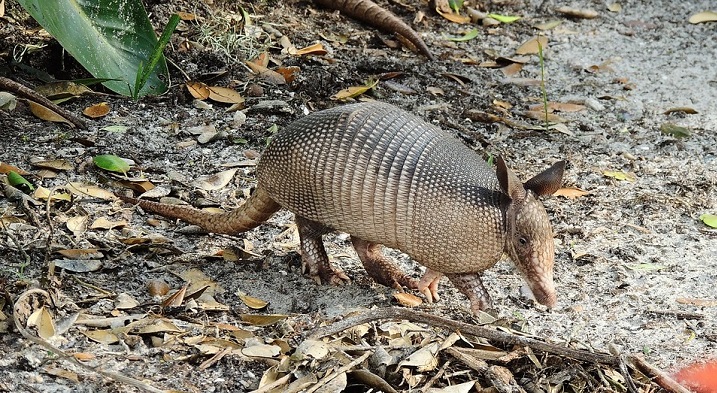
Armadillo pups spend the first few weeks of their lives underground, where they rely on their mothers for food and warmth. The female armadillo nurses and nurtures them for between two to four months, after which they’re expected to dig their own burrows and start fending for themselves.
Young armadillos mainly hunt for insects, practicing their digging techniques while foraging for a decent meal. It’s only later in life that they’ll have the skill and dexterity to hunt for scorpions, small vertebrates, and other larger prey species.
Most armadillos reach sexual maturity when they’re between 9 to 12 months old and will breed once a year from that point onwards.
Armadillos live comparatively long lives, with the nine-banded often surviving for between 12 and 20 years in the wild. The giant armadillo has a similar lifespan, usually living for around 15 years, while the pink fairy armadillo rarely survives beyond 10.
The Relationship Between Humans and Armadillos
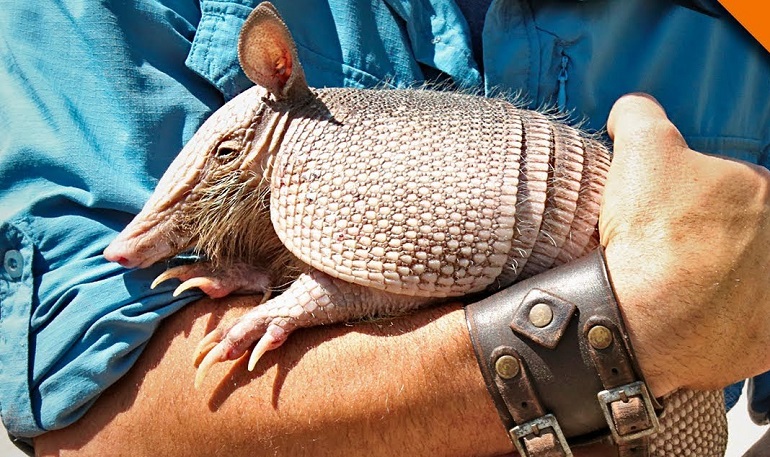
Although both humans and armadillos are mammals, that’s where the similarities end, but that hasn’t stopped the two species from complementing one another.
In an act of accidental conservation, humans have destroyed almost all the armadillo’s natural predators and built roads that have made it easier for them to move between different habitats and ranges.
The Armadillo in Science and Education
Sadly, humans are also responsible for some of the greatest threats to the armadillo. Not only do we hunt armadillos for their meat, but we’ve also used them in medicine.
Other than humans, armadillos are the only animals known to carry leprosy bacterium and have been used to research the effects of the disease on animals.
Despite the threats posed by humans, the population of nine-banded armadillos continues to thrive and expand.
It seems hunting these armored creatures isn’t that easy! One armadillo bounty hunter told The Guardian that hunting armadillos was like “hunting aliens,” saying, “We know nothing about them. We can’t seem to kill them easily.”
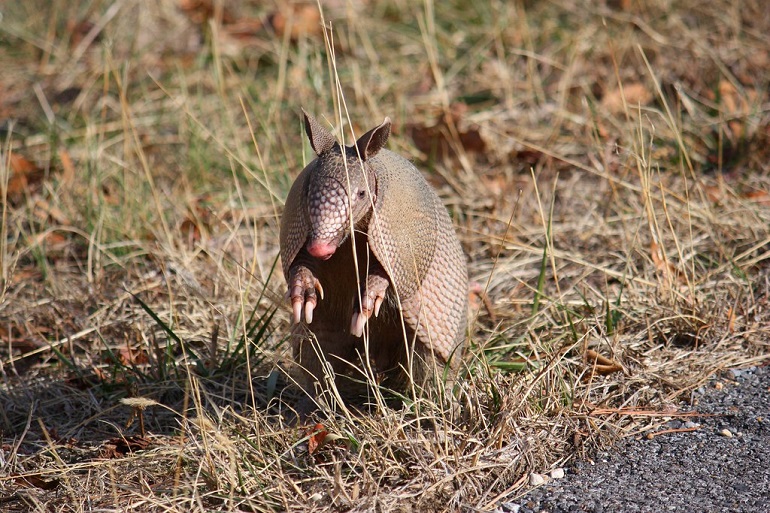
FAQ’s
Is the Armadillo Population Endangered?
Armadillos are thriving in the US and moving progressively further north. They have now settled in places that were previously too cold for them but, due to climate change, have now become suitable.
Not all armadillos are so fortunate, and the giant armadillo, in particular, is vulnerable to extinction, largely due to their habitat being destroyed.
The pink fairy and the hairy long-hosed armadillos remain a bit of a mystery as we don’t know enough about their populations to figure out exactly how they’re doing.
Hopefully, they’re doing as well as the hairy screaming armadillo, which according to the IUCN, currently has a stable population despite being relatively scarce.
Is the Armadillo a Mammal or Reptile?
Armadillos are mammals, but they look more like reptiles. Their hard shells offer protection, much like the alligator’s tough hide, but the two have little in common.
Conclusion
There are over 20 species of armadillos, ranging from the diminutive pink fairy to the giant armadillo, which is about the size of a small bar fridge.
Armadillos have such poor eyesight and become so focused when hunting that they will bump into your legs if you stand still for long enough. They make up for that with their long noses and keen sense of smell, which help them locate their prey and warn them of potential dangers.
There is no animal on earth quite like the armadillo. Shielded by its body armor, it scuttles around the undergrowth and digs for prey using its long nose and sharp claws.
Let’s hope that this unique creature continues to thrive, despite the various threats to its existence. Without it, our wildlife would be less diverse and far less entertaining.


